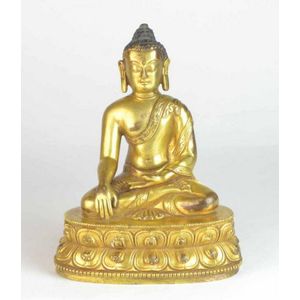Tibetan Medicine Buddha Bronze Figure, 17th/18th Century
You must be a subscriber, and be logged in to view price and dealer details.
Subscribe Now to view actual auction price for this item
When you subscribe, you have the option of setting the currency in which to display prices to $Au, $US, $NZ or Stg.
- Bronze - An alloy of copper and tin, traditionally in the proportions of about 9 parts of copper to 1 part of tin.
The discovery of bronze in Western Asia in the 4th century enabled people to create metal objects which were superior to those previoulsy possible because of its strength and hardness, and it has been used throughout the world for weapons, coins, tools, statuary and other decorative items.
It is very fluid in a molten state, and its hardness, strength when set, and non-corrosive properties makes it most suitable for casting sculpture.
This item has been included into following indexes:
-
Oriental deities, bronze
- Buddha 659
- Tibetan deities 132
- Oriental deities, Tibetan and Sino-Tibetan - Buddha and other deities 271
Visually similar items

A Mongolian gilt bronze figure of Bhaishajyaguru, height 21 cm

A gilt bronze figure of Shakyamuni Buddha, Tibeto-Chinese Qing dynasty, 18th century seated in dhyanasana on a double lotus base, the right hand lowered in bhumisparsamudra and the left in dhyanamudra wearing a loose robe draped over the left shoulder, the

A gilt bronze figure of Buddha, Qianlong mark and period the figure of Shakyamuni Buddha seated in meditative dhyanasana, the right arm lowered in bhumisparsamudra the left in dhyanamudra, wearing a loosely draped robe, the face with gentle expression and

A Chinese gilt bronze seated Buddha on double lotus throne. Height 12 cm
